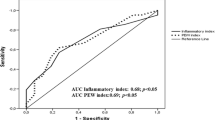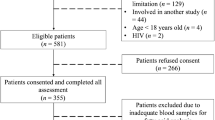Abstract
Purpose
Insulin resistance (IR) is a prevalent disorder in advanced renal failure irrespective of diabetes. Adipokines might play a role in IR, which has not been well-documented in uremic conditions. This study investigated the relationship of Zinc-α2-glycoprotein (ZAG), adipose triglyceride lipase (ATGL), and adipolin with glucose–insulin homeostasis in normal weight (NW) and obese (OB) patients with hemodialysis.
Methods
In this cross-sectional study, 59 patients (29 NW; 18.5 ≤ BMI < 25 kg/m2, and 30 OB; BMI ≥ 30 kg/m2) were studied. Anthropometries, circulating ZAG, adipolin, ATGL, free fatty acids (FFAs), fasting blood glucose (FBG), insulin, and homeostasis model assessment of IR (HOMA)-IR were assessed.
Results
There were no significant differences in age, gender, hemodialysis duration, dialysis adequacy and diabetes between the two groups. ZAG (100.9 ± 37.1 vs. 107.5 ± 30.5 ng/mL, P = 0.03) and adipolin (12.4 ± 1.6 vs. 13.2 ± 2.8 ng/mL, P = 0.002) concentrations were significantly lower, and FFAs (228.1 ± 112.6 vs. 185 ± 119 ng/mL, P = 0.014) were significantly higher in the OB than NW group. No significant differences were observed in ATGL, FBG, insulin and HOMA-IR between the two groups. Patients with lower IR had higher ZAG (112.9 ± 31.7 vs. 94.9 ± 34.5 ng/mL; P = 0.046), lower FFAs (167.8 ± 98.4 vs. 249.9 ± 120.8 ng/mL; P = 0.004), and marginally lower ATGL (9.1 ± 5.2 vs. 12.3 ± 9.6 mIU/mL; P = 0.079) concentrations than those with higher IR. ZAG was negatively (r = − 0.323, P = 0.018 and r = − 0.266, P = 0.054) and FFAs were positively (r = 0.321, P = 0.019 and r = 0.353, P = 0.009) correlated with insulin and HOMA-IR, respectively. ATGL was directly correlated with FFAs (r = 0.314, P = 0.018).
Conclusions
Novel adipokines, ZAG and ATGL, might contribute to glucose–insulin homeostasis in hemodialysis. Understanding potential causative, diagnostic or therapeutic roles of adipokines in IR require further studies.


Similar content being viewed by others
References
Stumvoll M, Goldstein BJ, van Haeften TW (2005) Type 2 diabetes: principles of pathogenesis and therapy. Lancet 365:1333–1346
Sampanis C (2008) Management of hyperglycemia in patients with diabetes mellitus and chronic renal failure. Hippokratia 12:22–27
Iglesias P, Diez JJ (2008) Insulin therapy in renal disease. Diabetes Obes Metab 10:811–823
Wesolowski P, Saracyn M, Nowak Z, Wankowicz Z (2010) Insulin resistance as a novel therapeutic target in patients with chronic kidney disease treated with dialysis. Pol Arch Med Wewn 120:54–57
Hung AM, Ikizler TA (2011) Factors determining insulin resistance in chronic hemodialysis patients. Contrib Nephrol 171:127–134
Kahn SE, Hull RL, Utzschneider KM (2006) Mechanisms linking obesity to insulin resistance and type 2 diabetes. Nature 444:840–846
Bing C, Bao Y, Jenkins J, Sanders P, Manieri M, Cinti S, Tisdale MJ, Trayhurn P (2004) Zinc-α2-glycoprotein, a lipid mobilizing factor, is expressed in adipocytes and is up-regulated in mice with cancer cachexia. Proc Natl Acad Sci USA 101:2500–2505
Zimmermann R, Lass A, Haemmerle G, Zechner R (2009) Fate of fat: the role of adipose triglyceride lipase in lipolysis. Biochim Biophys Acta 1791:494–500
Selva DM, Lecube A, Hernandez C, Baena JA, Fort JM, Simo R (2009) Lower zinc-α2-glycoprotein production by adipose tissue and liver in obese patients unrelated to insulin resistance. J Clin Endocrinol Metab 94:4499–4507
Ceperuelo-Mallafre V, Naf S, Escote X, Caubet E, Gomez JM, Miranda M, Chacon MR, Gonzalez-Clemente JM, Gallart L, Gutierrez C, Vendrell J (2009) Circulating and adipose tissue gene expression of zinc-α2-glycoprotein in obesity: its relationship with adipokine and lipolytic gene markers in subcutaneous and visceral fat. J Clin Endocrinol Metab 94:5062–5069
Yang L, Chen SJ, Yuan GY, Zhou LB, Wang D, Wang XZ, Chen JJ (2014) Association of serum adipose triglyceride lipase levels with obesity and diabetes. Gen Mol Res 13:6746–6751
Yeung DC, Lam KS, Wang Y, Tso AW, Xu A (2009) Serum zinc-alpha2-glycoprotein correlates with adiposity, triglycerides, and the key components of the metabolic syndrome in Chinese subjects. J Clin Endocrinol Metab 94:2531–2536
Xu S, Yang G, Yang M, Li S, Liu H, Li L (2011) Elevated adipose triglyceride lipase in newly diagnosed type 2 diabetes mellitus with hypertension. Am J Med Sci 342:452–455
Yao-Borengasser A, Varma V, Coker RH, Ranganathan G, Phanavanh B, Rasouli N, Kern PA (2011) Adipose triglyceride lipase expression in human adipose tissue and muscle. Role in insulin resistance and response to training and pioglitazone. Metabolism 60:1012–1020
Hosseinzadeh-Attar MJ, Mahdavi-Mazdeh M, Yaseri M, Zahed NS, Alipoor E (2017) Comparative assessment of serum adipokines Zinc-α2-glycoprotein and adipose triglyceride lipase, and cardiovascular risk factors between normal weight and obese patients with hemodialysis. Arch Med Res 48:459–466
Alipoor E, Esmaillzadeh A, Mahdavi-Mazdeh M, Yaseri M, Zahed NS, Hosseinzadeh-Attar MJ (2017) The relationship of serum adipokines with malnutrition inflammation score in haemodialysis. Eur J Clin Invest 47:545–554
Enomoto T, Ohashi K, Shibata R, Higuchi A, Maruyama S, Izumiya Y, Walsh K, Murohara T, Ouchi N (2011) Adipolin/C1qdc2/CTRP12 protein functions as an adipokine that improves glucose metabolism. J Biol Chem 286:34552–34558
Wei Z, Peterson JM, Lei X, Cebotaru L, Wolfgang MJ, Baldeviano GC, Wong GW (2012) C1q/TNF-related protein-12 (CTRP12), a novel adipokine that improves insulin sensitivity and glycemic control in mouse models of obesity and diabetes. J Biol Chem 287:10301–10315
Kalantar-Zadeh K, Kopple JD, Block G, Humphreys MH (2001) A malnutrition-inflammation score is correlated with morbidity and mortality in maintenance hemodialysis patients. Am J Kidney Dis 38:1251–1263
Nelson EE, Hong CD, Pesce AL, Peterson DW, Singh S, Pollak VE (1990) Anthropometric norms for the dialysis population. Am J Kidney Dis 16:32–37
Sit D, Kadiroglu AK, Yilmaz ME, Kara IH, Isikoglu B (2005) The prevalence of insulin resistance and its relationship between anemia, secondary hyperparathyroidism, inflammation, and cardiac parameters in chronic hemodialysis patients. Ren Fail 27:403–407
Zhou Y, Yu Z, Jia H, Sun F, Ma L, Guo R, Peng L, Cui T (2009) Association between insulin resistance and carotid arterial stiffness in nondiabetic hemodialysis patients. Blood Purif 28:193–199
Hung SC, Tarng DC (2009) Adiposity and insulin resistance in nondiabetic hemodialysis patients: effects of high energy supplementation. Am J Clin Nutr 90:64–69
Philipp A, Kralisch S, Bachmann A, Lossner U, Kratzsch J, Bluher M, Stumvoll M, Fasshauer M (2011) Serum levels of the adipokine zinc-α2-glycoprotein are increased in chronic hemodialysis. Metabolism 60:669–672
Naf S, Escote X, Yanez RE, Ballesteros M, Simon I, Gil P, Megia A, Vendrell J (2012) Zinc-α2-glycoprotein is unrelated to gestational diabetes: anthropometric and metabolic determinants in pregnant women and their offspring. PLoS ONE 7:e47601
Yang M, Liu R, Li S, Luo Y, Zhang Y, Zhang L, Liu D, Wang Y, Xiong Z, Boden G, Chen S, Li L, Yang G (2013) Zinc-α2-glycoprotein is associated with insulin resistance in humans and is regulated by hyperglycemia, hyperinsulinemia, or liraglutide administration: cross-sectional and interventional studies in normal subjects, insulin-resistant subjects, and subjects with newly diagnosed diabetes. Diabetes Care 36:1074–1082
Garrido-Sanchez L, Garcia-Fuentes E, Fernandez-Garcia D, Escote X, Alcaide J, Perez-Martinez P, Vendrell J, Tinahones FJ (2012) Zinc-α2-glycoprotein gene expression in adipose tissue is related with insulin resistance and lipolytic genes in morbidly obese patients. PLoS ONE 7:e33264
Tedeschi S, Pilotti E, Parenti E, Vicini V, Coghi P, Montanari A, Regolisti G, Fiaccadori E, Cabassi A (2012) Serum adipokine zinc-α2-glycoprotein and lipolysis in cachectic and noncachectic heart failure patients: relationship with neurohormonal and inflammatory biomarkers. Metabolism 61:37–42
Russell ST, Tisdale MJ (2010) Antidiabetic properties of zinc-α2-glycoprotein in ob/ob mice. Endocrinology 151:948–957
Enomoto T, Shibata R, Ohashi K, Kambara T, Kataoka Y, Uemura Y, Yuasa D, Murohara T, Ouchi N (2012) Regulation of adipolin/CTRP12 cleavage by obesity. Biochem Biophys Res Commun 428:155–159
Bai B, Ban B, Liu Z, Zhang MM, Tan BK, Chen J (2017) Circulating C1q complement/TNF-related protein (CTRP) 1, CTRP9, CTRP12 and CTRP13 concentrations in Type 2 diabetes mellitus: in vivo regulation by glucose. PLoS ONE 12:e0172271
Tan BK, Chen J, Adya R, Ramanjaneya M, Patel V, Randeva HS (2013) Metformin increases the novel adipokine adipolin/CTRP12: role of the AMPK pathway. J Endocrinol 219:101–108
Tan SY, Little HC, Lei X, Li S, Rodriguez S, Wong GW (2016) Partial deficiency of CTRP12 alters hepatic lipid metabolism. Physiol Genomics 48:936–949
Alipoor E, Salmani M, Yaseri M, Kolahdouz-Mohammadi R, Esteghamati A, Hosseinzadeh-Attar MJ (2019) Role of type 2 diabetes and hemodialysis in serum adipolin concentrations: a preliminary study. Hemodialysis Int 23:472–478
Schoenborn V, Heid IM, Vollmert C, Lingenhel A, Adams TD, Hopkins PN, Illig T, Zimmermann R, Zechner R, Hunt SC, Kronenberg F (2006) The ATGL gene is associated with free fatty acids, triglycerides, and type 2 diabetes. Diabetes 55:1270–1275
Berndt J, Kralisch S, Kloting N, Ruschke K, Kern M, Fasshauer M, Schon MR, Stumvoll M, Bluher M (2008) Adipose triglyceride lipase gene expression in human visceral obesity. Exp Clin Endocrinol Diabetes 116:203–210
Jocken JW, Langin D, Smit E, Saris WH, Valle C, Hul GB, Holm C, Arner P, Blaak EE (2007) Adipose triglyceride lipase and hormone-sensitive lipase protein expression is decreased in the obese insulin-resistant state. J Clin Endocrinol Metab 92:2292–2299
Haemmerle G, Lass A, Zimmermann R, Gorkiewicz G, Meyer C, Rozman J, Heldmaier G, Maier R, Theussl C, Eder S, Kratky D, Wagner EF, Klingenspor M, Hoefler G, Zechner R (2006) Defective lipolysis and altered energy metabolism in mice lacking adipose triglyceride lipase. Science 312:734–737
Zechner R, Kienesberger PC, Haemmerle G, Zimmermann R, Lass A (2009) Adipose triglyceride lipase and the lipolytic catabolism of cellular fat stores. J Lipid Res 50:3–21
Liu J, Jahn LA, Fowler DE, Barrett EJ, Cao W, Liu Z (2011) Free fatty acids induce insulin resistance in both cardiac and skeletal muscle microvasculature in humans. J Clin Endocrinol Metab 96:438–446
Delarue J, Magnan C (2007) Free fatty acids and insulin resistance. Curr Opin Clin Nutr Metab Care 10:142–148
Acknowledgements
This research has been supported by Tehran University of Medical Sciences and Health Services Grant 37227.
Author information
Authors and Affiliations
Corresponding author
Ethics declarations
Conflict of interest
The authors declare that they have no conflict of interest.
Ethics approval and informed consent
The ethics committee of the Tehran University of Medical Sciences approved this study and all patients completed a written informed consent. The study has been performed in accordance with the ethical standards of 1964 Declaration of Helsinki.
Consent to participate
Informed consent was obtained from all participants.
Additional information
Publisher's Note
Springer Nature remains neutral with regard to jurisdictional claims in published maps and institutional affiliations.
Rights and permissions
About this article
Cite this article
Alipoor, E., Yaseri, M., Mehrdadi, P. et al. The relationship between serum adipokines and glucose homeostasis in normal-weight and obese patients on hemodialysis: a preliminary study. Int Urol Nephrol 52, 2179–2187 (2020). https://doi.org/10.1007/s11255-020-02582-z
Received:
Accepted:
Published:
Issue Date:
DOI: https://doi.org/10.1007/s11255-020-02582-z




